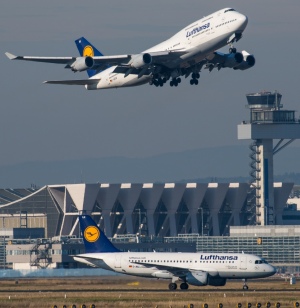

Engineers report that a strategy to reduce aircraft emissions during takeoff at London's Heathrow Airport is reaching its limits.
This is the first time we’ve been able to look at detailed flight operations on a second-by-second basis and our study has shown that pilots routinely use an engine thrust for take-off that leads to lower fuel consumption and emissions, without compromising safety standards.
– Dr Marc Stettler
Department of Civil and Environmental Engineering
The researchers from Imperial College London suggest the strategy to reduce emissions from planes taking off, using a setting called ‘reduced thrust,’ has increased fuel efficiency and reduced the levels of the pollutants nitrogen oxide (NOx) and black carbon (BC).
The strategy at London Heathrow Airport is reaching its limits in terms of what further reductions could be reached using this technology, so further decreases in emissions will have to be achieved by improvements to engine technologies and other sources.
Airlines implement reduced thrust settings during take-off as it reduces fuel consumption and engine maintenance costs. The procedure that pilots use to choose the thrust setting is ultimately determined by the onboard flight computer, which is installed by the manufacturers. However, airline policies and pilot training may influence the degree to which reduce thrust settings are implemented.
Dr Marc Stettler, the co-author of the study from the Department of Civil and Environmental Engineering at Imperial, said: “This is the first time we’ve been able to look at aircraft data during take-offs on a second-by-second basis. Our study has shown that pilots routinely use an engine thrust for take-off that leads to lower fuel consumption and emissions, without compromising safety standards. That’s positive news, but our work suggests that Heathrow will now need to look elsewhere to cut emission levels further.
Airport strategy: road emission reductions needed
Dr Stettler added: "While the introduction of new cleaner aircraft will continue to reduce emissions, reducing road transport emissions around the airport by changing the behaviour of those travelling to the airport could be a faster and more effective solution. Now that the Government has backed the expansion of Heathrow there is a need for a close examination of how we can tackle the projected overall increase in emissions around the airport in the future.”

The team analysed data from 3,336 reduced thrust takeoffs at Heathrow Airport as part of the study.
“Our study indicates that significant improvements in air quality, specifically NOx can only be achieved with a strategy that fully addresses road traffic emissions around the airport, which is the major emissions source. According to Heathrow’s own figures, approximately 60 percent of passengers currently travel to Heathrow by private transport. New infrastructure projects like HS2 could help alleviate some of the pressure by making it easier for people to get to Heathrow on public transport.”
The strategy: analysing reduced thrust takeoffs
In the study, which is published in the journal Transportation Research Part D: Transport and Environment, the team analysed the use of reduced thrust at Heathrow. Reduced thrust enables pilots to reduce the propulsive force generated by the engines if the aircraft is not full of people and cargo. The researchers showed that there were significant benefits in terms of reducing fuel consumption and emissions. They were also able to quantify how consistently the reduced thrust setting was applied.
The Imperial team analysed departure data records from 3,336 reduced thrust take-offs at Heathrow Airport. They looked at one commercial aircraft carrier and compared six different types of planes in its fleet, made by the manufacturers Boeing and Airbus. The reduced thrust take-off figures were compared to if the planes employed a 100 per cent thrust take-off procedure. The team found that reducing engine thrust during take-off decreases fuel consumption by 23.2 per cent, NOx by up to 47.7 per cent and BC emissions by up to 71.1 per cent.
Overall, the team say the results clearly show the positive contribution that the reduced thrust strategy offers towards achieving industry environmental targets and air quality compliance.
Next steps
The researchers also calculated that planes taking off at Heathrow could make further savings of 1.9 per cent, 5.8 per cent and 6.5 per cent respectively in fuel consumption, NOx and BC emissions if the thrust setting was optimised for the take-off weight of the aircraft. In terms of overall ground-level aircraft emissions at the airport, this would equate to reductions of 0.4 per cent for fuel consumption, 3.5 per cent for NOx, and 3.3 per cent for BC emissions. The team say these relatively small reductions imply that the strategy is near optimal at Heathrow when operational and safety constraints are taken into consideration.
The next steps will see the team evaluate other operational strategies to reduce aircraft emissions at Heathrow and the team are collaborating with Cambridge University to quantify aircraft contributions to air pollution measurements from a sensor network deployed at Heathrow.
This project was supported by the Natural Environmental Research Council and the Lloyds Register Foundation.
Article text (excluding photos or graphics) available under an Attribution-NonCommercial-ShareAlike Creative Commons license.
Photos and graphics subject to third party copyright used with permission or © Imperial College London.
Reporter
Colin Smith
Communications and Public Affairs

Contact details
Email: press.office@imperial.ac.uk
Show all stories by this author
Leave a comment
Your comment may be published, displaying your name as you provide it, unless you request otherwise. Your contact details will never be published.




Comments
Comments are loading...